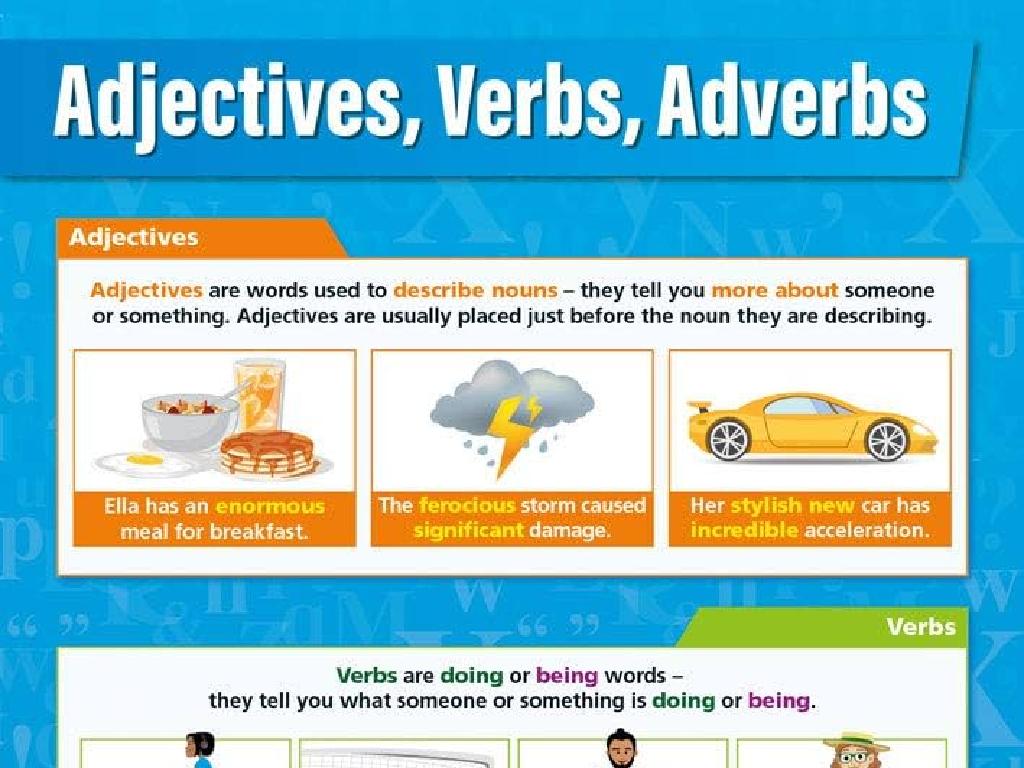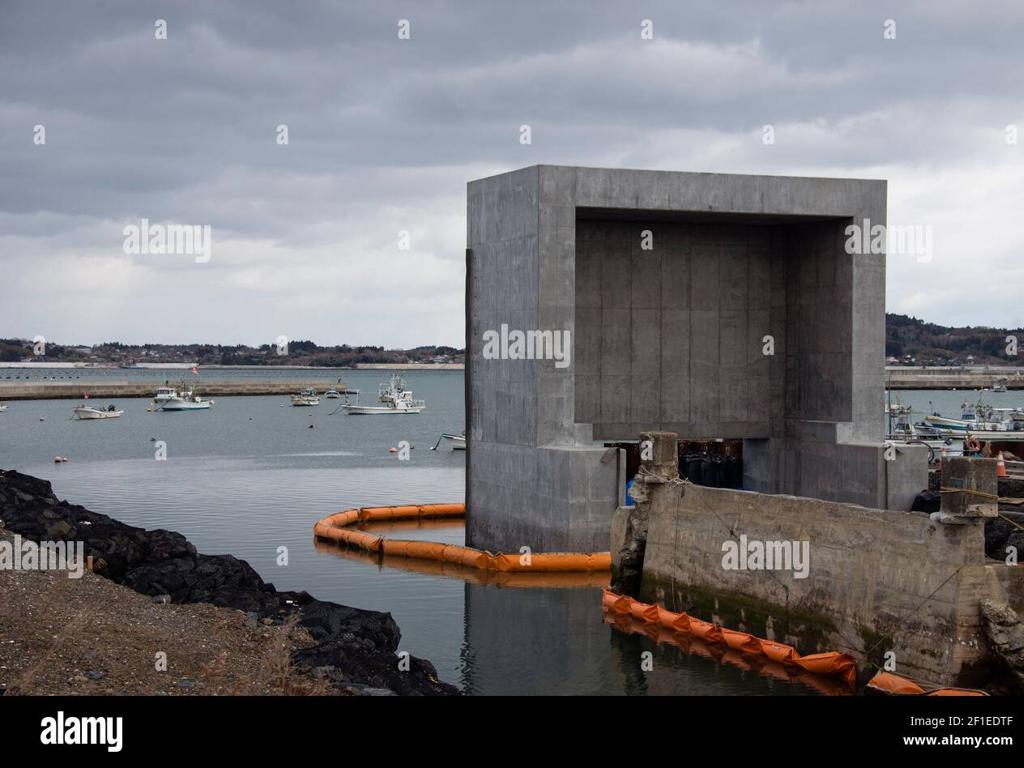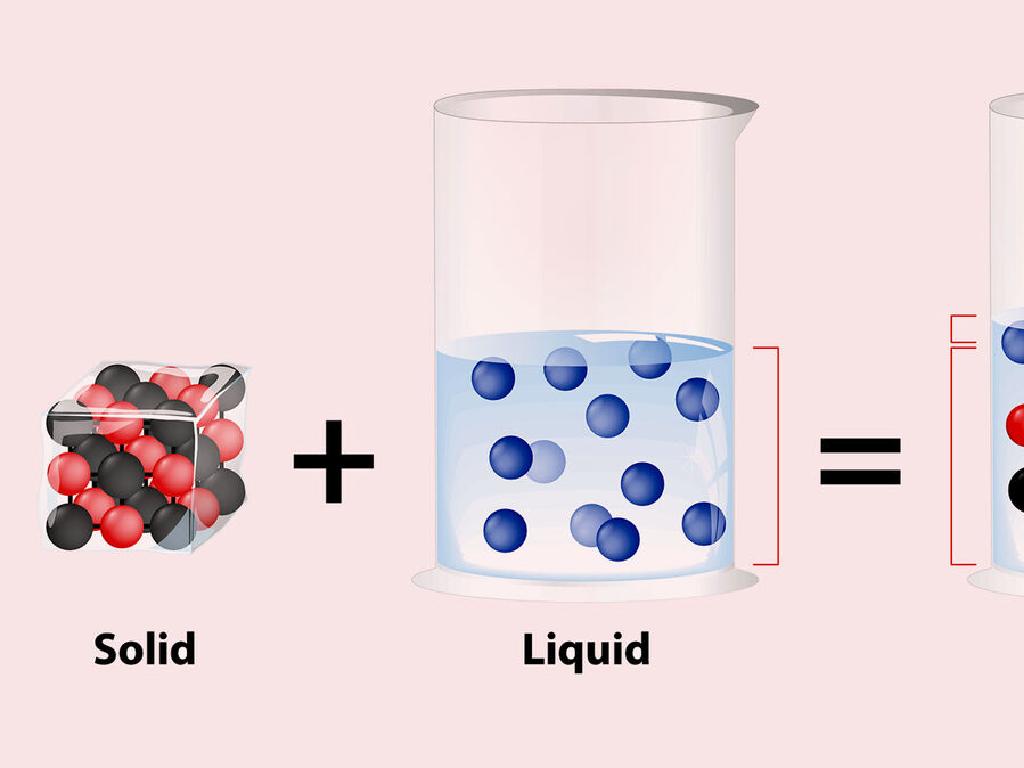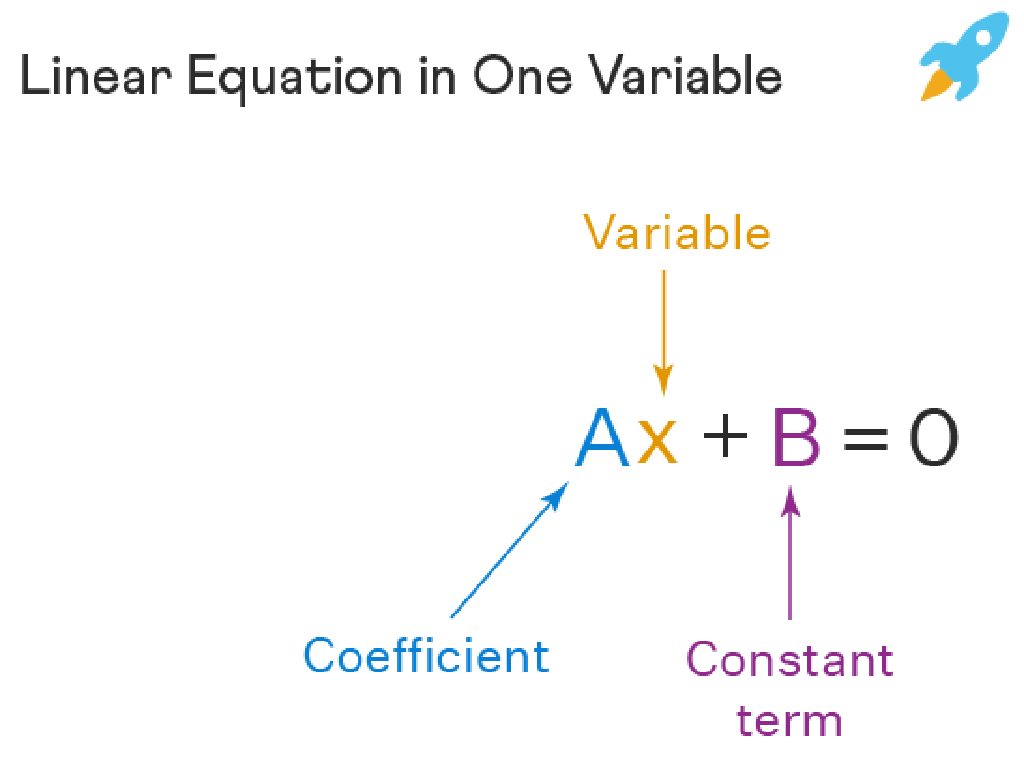Calculate Time From Velocity And Distance
Subject: Science
Grade: Eighth grade
Topic: Chemical Reactions
Please LOG IN to download the presentation. Access is available to registered users only.
View More Content
Chemical Reactions: Time, Velocity & Distance
– Basics of chemical reactions
– A process where substances change into new ones.
– Reactions in daily life
– Cooking, rusting, and photosynthesis are common examples.
– Calculating time in reactions
– Time = Distance / Velocity, crucial for reaction rates.
– Preview of upcoming concepts
|
This slide introduces students to the fundamental concepts of chemical reactions, emphasizing their prevalence in everyday life and the importance of understanding reaction rates. Begin by explaining that a chemical reaction involves the transformation of substances into different substances through the breaking and forming of chemical bonds. Illustrate with relatable examples like cooking, where heat causes chemical changes in food, or rusting, where oxygen reacts with metal. Introduce the formula for calculating time from velocity and distance, which is essential for understanding how fast reactions occur. This will set the stage for more in-depth exploration of reaction rates and the factors that affect them. Encourage students to think of other daily examples of chemical reactions and consider the speed at which they happen.
Understanding Velocity in Chemical Reactions
– Velocity: Speed with direction
– Velocity is not just speed; it includes direction, like 60 km/h north.
– Velocity’s role in reactions
– In reactions, velocity can affect how quickly substances react.
– Common units of velocity
– Meters per second (m/s) is the SI unit for velocity.
– Calculating reaction time
|
This slide introduces the concept of velocity within the context of chemical reactions. Velocity is defined as speed with a specified direction, which is crucial when considering the rate at which reactants come together or products are formed. Provide examples of how different velocities can affect reaction times, such as faster-moving particles leading to quicker reactions. Discuss the standard units of velocity, emphasizing meters per second (m/s) as the SI unit. Conclude by explaining how to use velocity and distance to calculate the time it takes for a reaction to occur, setting the stage for problem-solving in class.
Understanding Distance in Chemical Reactions
– Define distance in reactions
Distance is the total path length traveled during a reaction.
– Distance vs. displacement
Distance is a scalar quantity, while displacement is a vector with direction.
– Common units of distance
Meters (m), centimeters (cm), and millimeters (mm) are typical units.
– Calculating distance in reactions
|
This slide introduces the concept of distance as it relates to chemical reactions, which is crucial when discussing the movement of particles during a reaction. Distance refers to how much ground an object has covered during its motion, regardless of its starting or ending point. It’s important to differentiate between distance and displacement, as displacement includes direction and is the shortest path between two points. Common units of distance are meters, centimeters, and millimeters, which students should be familiar with. When calculating time from velocity and distance, understanding the units and how to measure distance accurately is essential. Encourage students to think about how particles move and cover distance during reactions, and how this might affect the rate of a reaction.
Time Calculation in Chemical Reactions
– Time calculation formula
– time = distance / velocity
– Components of the formula
– Distance covered and speed of reaction
– Significance in reactions
– Accurate timing can affect reaction outcomes
– Applying the formula
– Use the formula to predict reaction duration
|
This slide introduces the concept of calculating time within the context of chemical reactions, which is crucial for understanding reaction rates. The formula ‘time = distance / velocity’ is a fundamental equation in physics, but it can be applied metaphorically to chemical reactions where ‘distance’ represents the extent of reaction and ‘velocity’ the rate at which reactants turn into products. Understanding each component of the formula helps students grasp the relationship between the speed of a reaction and the time it takes to complete. Emphasize the importance of time calculation in experiments and real-world applications, such as pharmaceutical drug creation, where precise reaction timing can be critical. Encourage students to practice applying the formula to various scenarios to become comfortable with predicting the duration of reactions.
Calculating Reaction Time
– Understanding the formula: time = distance/velocity
– Step-by-step calculation guide
– Identify distance traveled and velocity, then divide
– Example: Reaction completion time
– If a reaction travels 300 meters at 75 m/s, how long does it take?
– Practice problem for students
– Solve for time in a given scenario
|
This slide is aimed at teaching students how to calculate the time it takes for a chemical reaction to complete using the formula time = distance/velocity. Start by explaining the components of the formula, where ‘distance’ refers to the length of the reaction pathway and ‘velocity’ is the speed at which the reaction progresses. Use a real-world example, such as a reaction traveling a certain distance at a known speed, to illustrate the calculation. Then, provide a practice problem for the students to solve, reinforcing their understanding of the concept. Ensure to walk through the step-by-step process during the lesson, and encourage students to ask questions if they’re unsure about any part of the calculation.
Factors Affecting Reaction Rates
– Temperature’s impact on rates
– Higher temperatures usually increase reaction rates.
– Concentration effects
– Greater concentration can lead to more frequent collisions.
– Role of catalysts
– Catalysts speed up reactions without being consumed.
– Reaction rates and time
– Understanding rates helps calculate how long a reaction takes.
|
This slide aims to explain the various factors that can affect the rate at which chemical reactions occur. Temperature is a key factor; as it increases, molecules move faster, leading to more collisions and a faster reaction rate. Concentration also plays a role; a higher concentration of reactants leads to an increased likelihood of particle collisions. Catalysts are substances that increase the rate of a reaction without being consumed in the process. Lastly, understanding these factors helps us to calculate the time it takes for a reaction to complete, which is crucial in industrial processes and research. Provide real-world examples such as the use of catalysts in vehicle exhaust systems to illustrate these concepts.
Class Activity: Reaction Race
– Conduct a simple chemical reaction
– Measure reactant’s travel distance
– Record the time of reaction
– Calculate reaction time using formula
– Use formula: time = distance / velocity
|
In this engaging class activity, students will conduct a hands-on chemical reaction experiment. They will observe a reactant moving and measure how far it travels over a period of time. Students should record the distance traveled and the time taken. After the experiment, they will apply the formula ‘time = distance / velocity’ to calculate the time taken for the reaction to occur. This activity will help students understand the practical application of the formula and reinforce their understanding of reaction rates. Possible variations of the activity could include changing the concentration of reactants, using different reactants, or measuring the effect of temperature on the reaction time.
Conclusion: Time, Velocity, and Chemical Reactions
– Recap: Time from velocity & distance
– Time = Distance ÷ Velocity. Remember to use consistent units!
– Why it’s key in chemical reactions
– Reaction rates depend on time, which is found through this calculation.
– Encourage questions & discussion
– There are no bad questions. Understanding comes from curiosity!
– Apply knowledge to experiments
|
As we wrap up, revisit the formula for calculating time from velocity and distance, emphasizing the importance of unit consistency. Highlight how this calculation is crucial for understanding reaction rates in chemical reactions, as the speed of reactants coming together can affect the time it takes for a reaction to occur. Encourage students to ask any lingering questions they might have and to engage in a discussion to clarify their understanding. Finally, inspire them to apply this knowledge in future experiments, predicting reaction times and observing outcomes. This will solidify their grasp of the concept and its relevance to real-world scenarios.






